Microeconomics Project: Market Structure Analysis and Critique
VerifiedAdded on 2023/01/18
|14
|2326
|91
Project
AI Summary
This project is a comprehensive analysis of four key market structures: perfect competition, monopoly, monopolistic competition, and oligopoly. The assignment requires a critical review of articles related to each market structure, including an examination of the basic theme, critical review, relevant terminology, and positive and normative arguments presented in the articles. The student analyzes articles from various sources, providing insights into real-world applications of microeconomic concepts. The project includes a title page, table of contents, and a detailed critique for each article, connecting the concepts to the course material and offering the student's opinion on the issues discussed. This assignment demonstrates the student's ability to apply microeconomic theory to real-world scenarios and analyze market dynamics, showcasing a strong understanding of market structures and their implications.
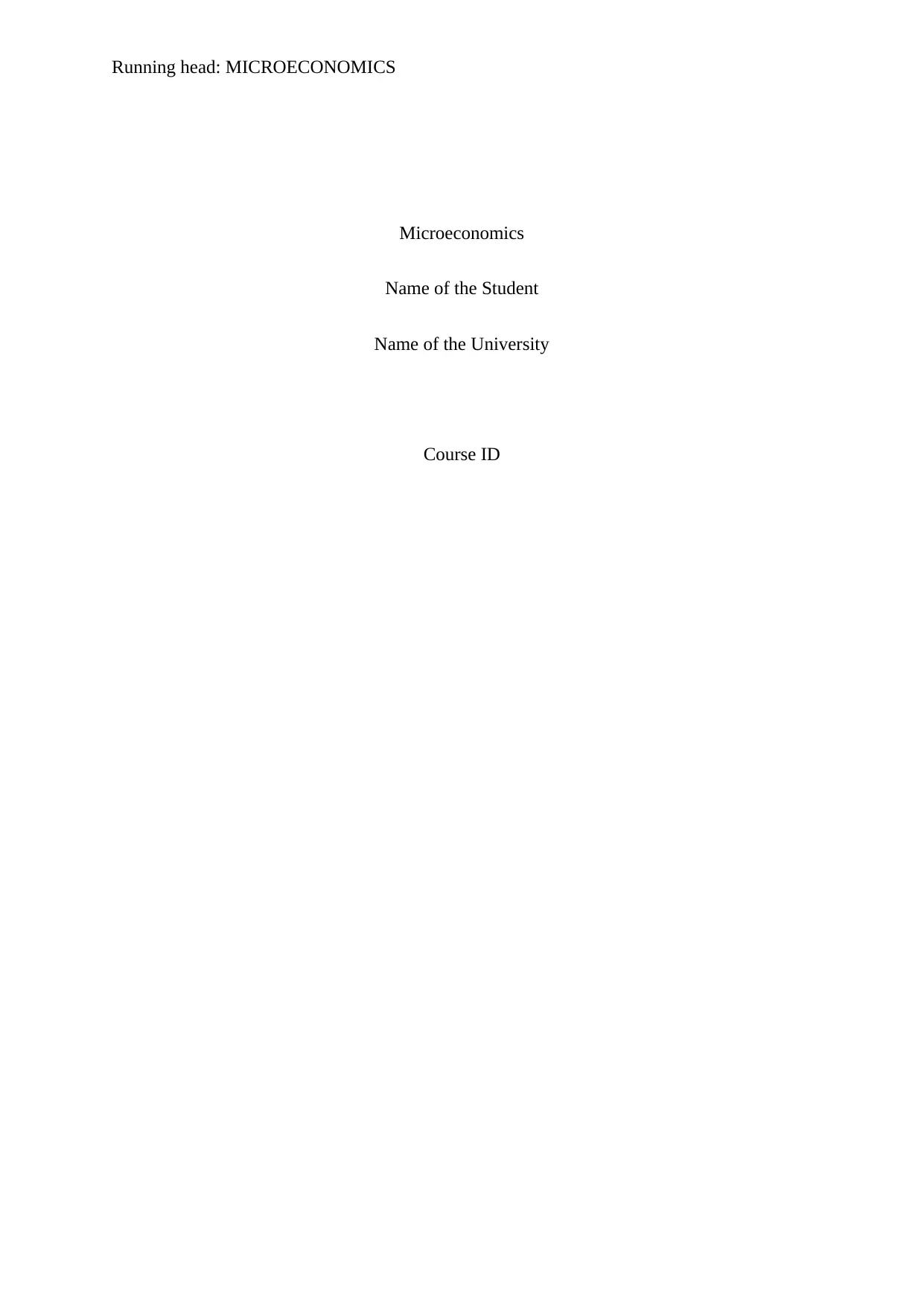
Running head: MICROECONOMICS
Microeconomics
Name of the Student
Name of the University
Course ID
Microeconomics
Name of the Student
Name of the University
Course ID
Paraphrase This Document
Need a fresh take? Get an instant paraphrase of this document with our AI Paraphraser

1MICROECONOMICS
Table of Contents
Perfect Competition...................................................................................................................2
Article:....................................................................................................................................2
Author:...................................................................................................................................2
Source:....................................................................................................................................2
Date:.......................................................................................................................................2
Monopoly...................................................................................................................................4
Article:....................................................................................................................................4
Author:...................................................................................................................................4
Source:....................................................................................................................................4
Date:.......................................................................................................................................4
Monopolistic competition..........................................................................................................6
Article:....................................................................................................................................6
Author:...................................................................................................................................6
Source:....................................................................................................................................6
Date:.......................................................................................................................................6
Oligopoly....................................................................................................................................8
Article:....................................................................................................................................8
Author:...................................................................................................................................8
Source:....................................................................................................................................8
Date:.......................................................................................................................................8
References................................................................................................................................11
Table of Contents
Perfect Competition...................................................................................................................2
Article:....................................................................................................................................2
Author:...................................................................................................................................2
Source:....................................................................................................................................2
Date:.......................................................................................................................................2
Monopoly...................................................................................................................................4
Article:....................................................................................................................................4
Author:...................................................................................................................................4
Source:....................................................................................................................................4
Date:.......................................................................................................................................4
Monopolistic competition..........................................................................................................6
Article:....................................................................................................................................6
Author:...................................................................................................................................6
Source:....................................................................................................................................6
Date:.......................................................................................................................................6
Oligopoly....................................................................................................................................8
Article:....................................................................................................................................8
Author:...................................................................................................................................8
Source:....................................................................................................................................8
Date:.......................................................................................................................................8
References................................................................................................................................11
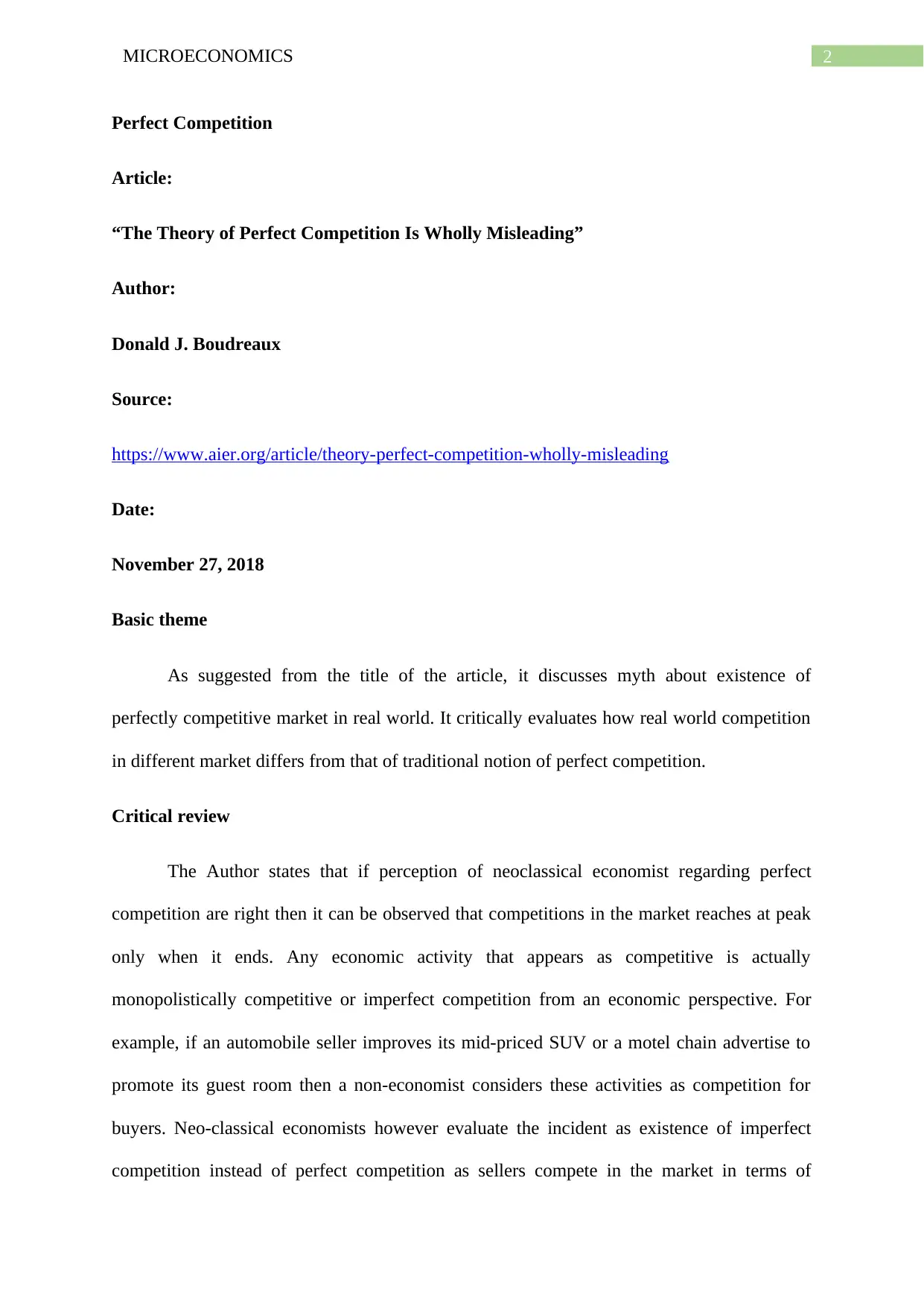
2MICROECONOMICS
Perfect Competition
Article:
“The Theory of Perfect Competition Is Wholly Misleading”
Author:
Donald J. Boudreaux
Source:
https://www.aier.org/article/theory-perfect-competition-wholly-misleading
Date:
November 27, 2018
Basic theme
As suggested from the title of the article, it discusses myth about existence of
perfectly competitive market in real world. It critically evaluates how real world competition
in different market differs from that of traditional notion of perfect competition.
Critical review
The Author states that if perception of neoclassical economist regarding perfect
competition are right then it can be observed that competitions in the market reaches at peak
only when it ends. Any economic activity that appears as competitive is actually
monopolistically competitive or imperfect competition from an economic perspective. For
example, if an automobile seller improves its mid-priced SUV or a motel chain advertise to
promote its guest room then a non-economist considers these activities as competition for
buyers. Neo-classical economists however evaluate the incident as existence of imperfect
competition instead of perfect competition as sellers compete in the market in terms of
Perfect Competition
Article:
“The Theory of Perfect Competition Is Wholly Misleading”
Author:
Donald J. Boudreaux
Source:
https://www.aier.org/article/theory-perfect-competition-wholly-misleading
Date:
November 27, 2018
Basic theme
As suggested from the title of the article, it discusses myth about existence of
perfectly competitive market in real world. It critically evaluates how real world competition
in different market differs from that of traditional notion of perfect competition.
Critical review
The Author states that if perception of neoclassical economist regarding perfect
competition are right then it can be observed that competitions in the market reaches at peak
only when it ends. Any economic activity that appears as competitive is actually
monopolistically competitive or imperfect competition from an economic perspective. For
example, if an automobile seller improves its mid-priced SUV or a motel chain advertise to
promote its guest room then a non-economist considers these activities as competition for
buyers. Neo-classical economists however evaluate the incident as existence of imperfect
competition instead of perfect competition as sellers compete in the market in terms of
⊘ This is a preview!⊘
Do you want full access?
Subscribe today to unlock all pages.

Trusted by 1+ million students worldwide
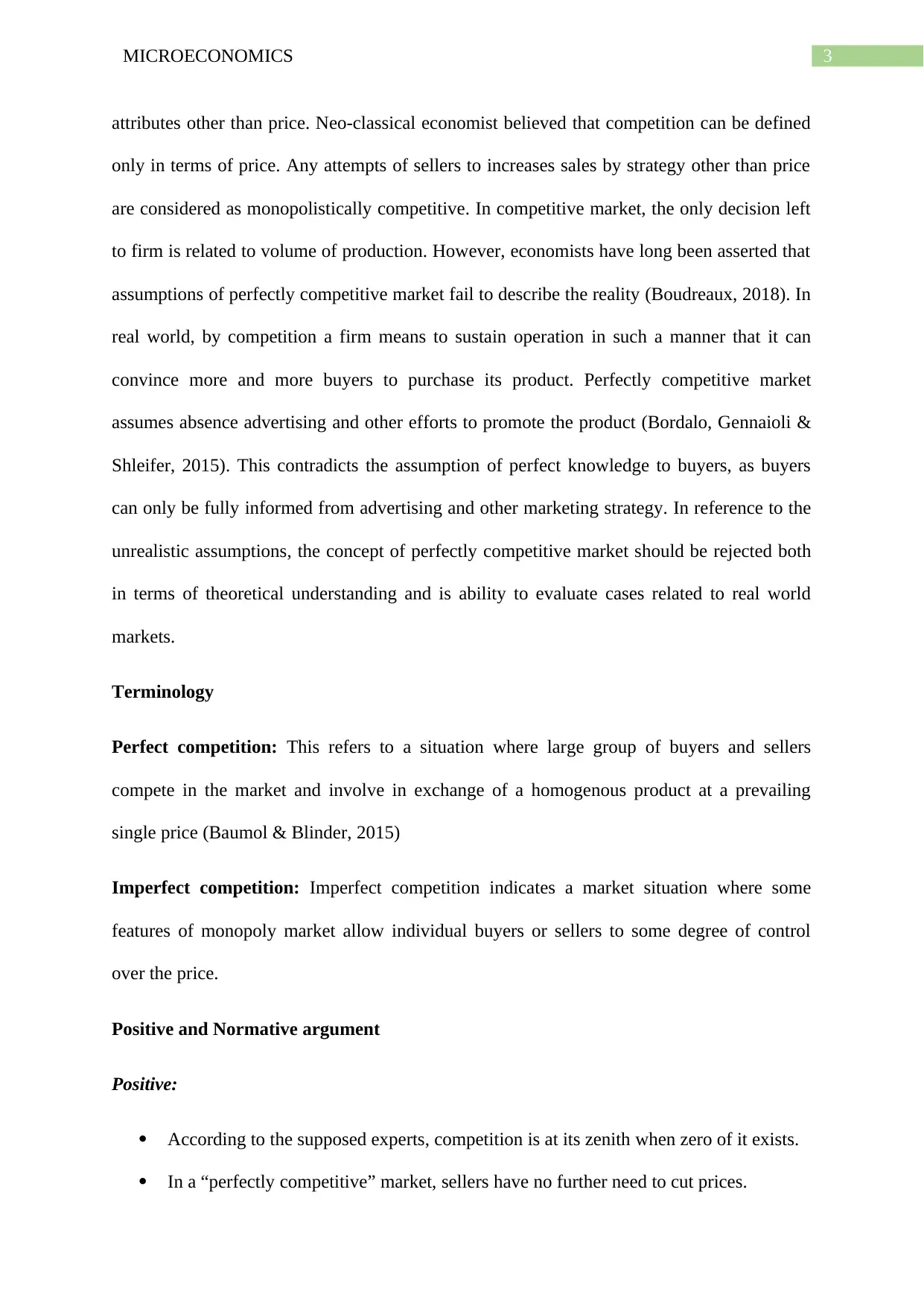
3MICROECONOMICS
attributes other than price. Neo-classical economist believed that competition can be defined
only in terms of price. Any attempts of sellers to increases sales by strategy other than price
are considered as monopolistically competitive. In competitive market, the only decision left
to firm is related to volume of production. However, economists have long been asserted that
assumptions of perfectly competitive market fail to describe the reality (Boudreaux, 2018). In
real world, by competition a firm means to sustain operation in such a manner that it can
convince more and more buyers to purchase its product. Perfectly competitive market
assumes absence advertising and other efforts to promote the product (Bordalo, Gennaioli &
Shleifer, 2015). This contradicts the assumption of perfect knowledge to buyers, as buyers
can only be fully informed from advertising and other marketing strategy. In reference to the
unrealistic assumptions, the concept of perfectly competitive market should be rejected both
in terms of theoretical understanding and is ability to evaluate cases related to real world
markets.
Terminology
Perfect competition: This refers to a situation where large group of buyers and sellers
compete in the market and involve in exchange of a homogenous product at a prevailing
single price (Baumol & Blinder, 2015)
Imperfect competition: Imperfect competition indicates a market situation where some
features of monopoly market allow individual buyers or sellers to some degree of control
over the price.
Positive and Normative argument
Positive:
According to the supposed experts, competition is at its zenith when zero of it exists.
In a “perfectly competitive” market, sellers have no further need to cut prices.
attributes other than price. Neo-classical economist believed that competition can be defined
only in terms of price. Any attempts of sellers to increases sales by strategy other than price
are considered as monopolistically competitive. In competitive market, the only decision left
to firm is related to volume of production. However, economists have long been asserted that
assumptions of perfectly competitive market fail to describe the reality (Boudreaux, 2018). In
real world, by competition a firm means to sustain operation in such a manner that it can
convince more and more buyers to purchase its product. Perfectly competitive market
assumes absence advertising and other efforts to promote the product (Bordalo, Gennaioli &
Shleifer, 2015). This contradicts the assumption of perfect knowledge to buyers, as buyers
can only be fully informed from advertising and other marketing strategy. In reference to the
unrealistic assumptions, the concept of perfectly competitive market should be rejected both
in terms of theoretical understanding and is ability to evaluate cases related to real world
markets.
Terminology
Perfect competition: This refers to a situation where large group of buyers and sellers
compete in the market and involve in exchange of a homogenous product at a prevailing
single price (Baumol & Blinder, 2015)
Imperfect competition: Imperfect competition indicates a market situation where some
features of monopoly market allow individual buyers or sellers to some degree of control
over the price.
Positive and Normative argument
Positive:
According to the supposed experts, competition is at its zenith when zero of it exists.
In a “perfectly competitive” market, sellers have no further need to cut prices.
Paraphrase This Document
Need a fresh take? Get an instant paraphrase of this document with our AI Paraphraser
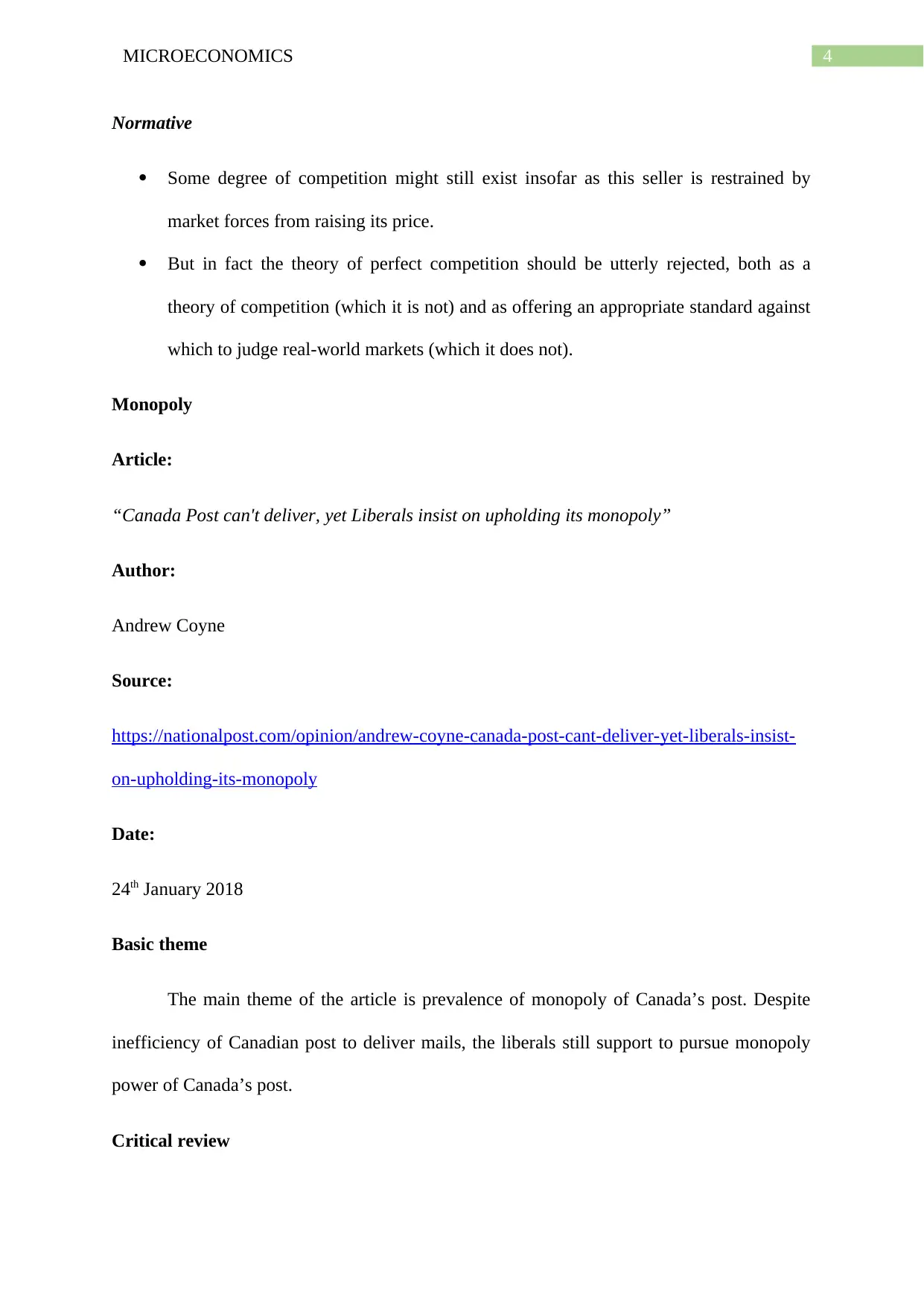
4MICROECONOMICS
Normative
Some degree of competition might still exist insofar as this seller is restrained by
market forces from raising its price.
But in fact the theory of perfect competition should be utterly rejected, both as a
theory of competition (which it is not) and as offering an appropriate standard against
which to judge real-world markets (which it does not).
Monopoly
Article:
“Canada Post can't deliver, yet Liberals insist on upholding its monopoly”
Author:
Andrew Coyne
Source:
https://nationalpost.com/opinion/andrew-coyne-canada-post-cant-deliver-yet-liberals-insist-
on-upholding-its-monopoly
Date:
24th January 2018
Basic theme
The main theme of the article is prevalence of monopoly of Canada’s post. Despite
inefficiency of Canadian post to deliver mails, the liberals still support to pursue monopoly
power of Canada’s post.
Critical review
Normative
Some degree of competition might still exist insofar as this seller is restrained by
market forces from raising its price.
But in fact the theory of perfect competition should be utterly rejected, both as a
theory of competition (which it is not) and as offering an appropriate standard against
which to judge real-world markets (which it does not).
Monopoly
Article:
“Canada Post can't deliver, yet Liberals insist on upholding its monopoly”
Author:
Andrew Coyne
Source:
https://nationalpost.com/opinion/andrew-coyne-canada-post-cant-deliver-yet-liberals-insist-
on-upholding-its-monopoly
Date:
24th January 2018
Basic theme
The main theme of the article is prevalence of monopoly of Canada’s post. Despite
inefficiency of Canadian post to deliver mails, the liberals still support to pursue monopoly
power of Canada’s post.
Critical review
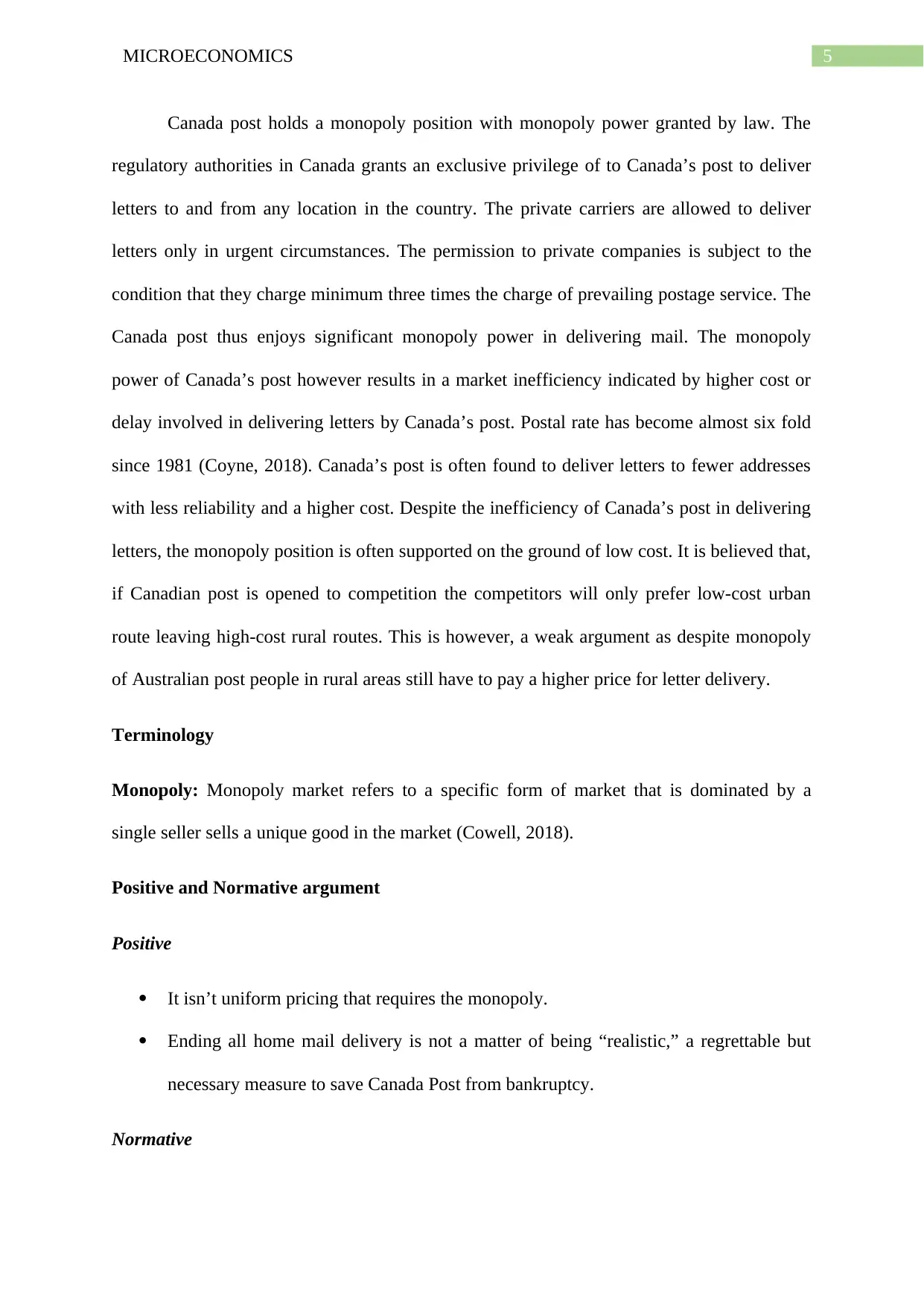
5MICROECONOMICS
Canada post holds a monopoly position with monopoly power granted by law. The
regulatory authorities in Canada grants an exclusive privilege of to Canada’s post to deliver
letters to and from any location in the country. The private carriers are allowed to deliver
letters only in urgent circumstances. The permission to private companies is subject to the
condition that they charge minimum three times the charge of prevailing postage service. The
Canada post thus enjoys significant monopoly power in delivering mail. The monopoly
power of Canada’s post however results in a market inefficiency indicated by higher cost or
delay involved in delivering letters by Canada’s post. Postal rate has become almost six fold
since 1981 (Coyne, 2018). Canada’s post is often found to deliver letters to fewer addresses
with less reliability and a higher cost. Despite the inefficiency of Canada’s post in delivering
letters, the monopoly position is often supported on the ground of low cost. It is believed that,
if Canadian post is opened to competition the competitors will only prefer low-cost urban
route leaving high-cost rural routes. This is however, a weak argument as despite monopoly
of Australian post people in rural areas still have to pay a higher price for letter delivery.
Terminology
Monopoly: Monopoly market refers to a specific form of market that is dominated by a
single seller sells a unique good in the market (Cowell, 2018).
Positive and Normative argument
Positive
It isn’t uniform pricing that requires the monopoly.
Ending all home mail delivery is not a matter of being “realistic,” a regrettable but
necessary measure to save Canada Post from bankruptcy.
Normative
Canada post holds a monopoly position with monopoly power granted by law. The
regulatory authorities in Canada grants an exclusive privilege of to Canada’s post to deliver
letters to and from any location in the country. The private carriers are allowed to deliver
letters only in urgent circumstances. The permission to private companies is subject to the
condition that they charge minimum three times the charge of prevailing postage service. The
Canada post thus enjoys significant monopoly power in delivering mail. The monopoly
power of Canada’s post however results in a market inefficiency indicated by higher cost or
delay involved in delivering letters by Canada’s post. Postal rate has become almost six fold
since 1981 (Coyne, 2018). Canada’s post is often found to deliver letters to fewer addresses
with less reliability and a higher cost. Despite the inefficiency of Canada’s post in delivering
letters, the monopoly position is often supported on the ground of low cost. It is believed that,
if Canadian post is opened to competition the competitors will only prefer low-cost urban
route leaving high-cost rural routes. This is however, a weak argument as despite monopoly
of Australian post people in rural areas still have to pay a higher price for letter delivery.
Terminology
Monopoly: Monopoly market refers to a specific form of market that is dominated by a
single seller sells a unique good in the market (Cowell, 2018).
Positive and Normative argument
Positive
It isn’t uniform pricing that requires the monopoly.
Ending all home mail delivery is not a matter of being “realistic,” a regrettable but
necessary measure to save Canada Post from bankruptcy.
Normative
⊘ This is a preview!⊘
Do you want full access?
Subscribe today to unlock all pages.

Trusted by 1+ million students worldwide
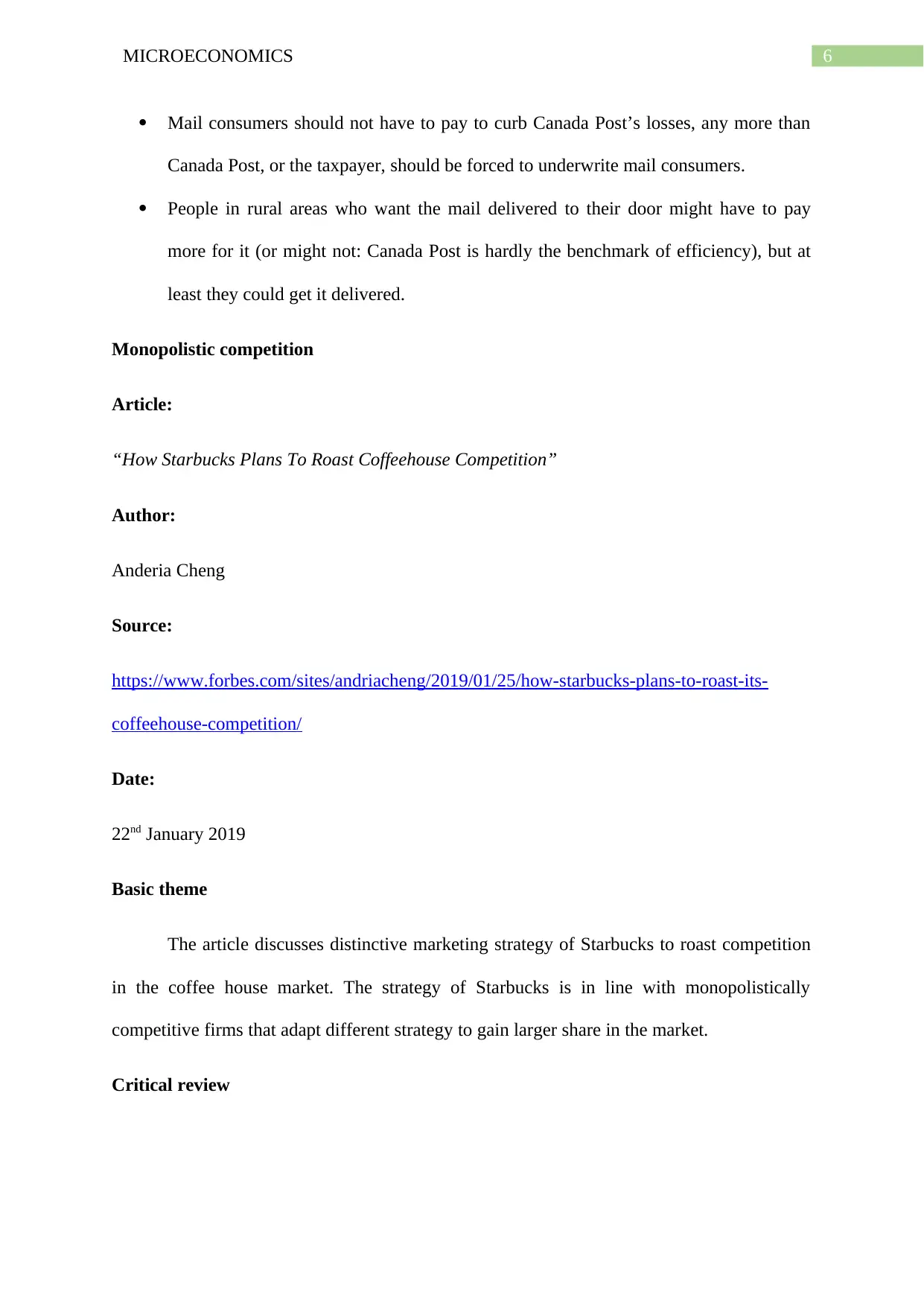
6MICROECONOMICS
Mail consumers should not have to pay to curb Canada Post’s losses, any more than
Canada Post, or the taxpayer, should be forced to underwrite mail consumers.
People in rural areas who want the mail delivered to their door might have to pay
more for it (or might not: Canada Post is hardly the benchmark of efficiency), but at
least they could get it delivered.
Monopolistic competition
Article:
“How Starbucks Plans To Roast Coffeehouse Competition”
Author:
Anderia Cheng
Source:
https://www.forbes.com/sites/andriacheng/2019/01/25/how-starbucks-plans-to-roast-its-
coffeehouse-competition/
Date:
22nd January 2019
Basic theme
The article discusses distinctive marketing strategy of Starbucks to roast competition
in the coffee house market. The strategy of Starbucks is in line with monopolistically
competitive firms that adapt different strategy to gain larger share in the market.
Critical review
Mail consumers should not have to pay to curb Canada Post’s losses, any more than
Canada Post, or the taxpayer, should be forced to underwrite mail consumers.
People in rural areas who want the mail delivered to their door might have to pay
more for it (or might not: Canada Post is hardly the benchmark of efficiency), but at
least they could get it delivered.
Monopolistic competition
Article:
“How Starbucks Plans To Roast Coffeehouse Competition”
Author:
Anderia Cheng
Source:
https://www.forbes.com/sites/andriacheng/2019/01/25/how-starbucks-plans-to-roast-its-
coffeehouse-competition/
Date:
22nd January 2019
Basic theme
The article discusses distinctive marketing strategy of Starbucks to roast competition
in the coffee house market. The strategy of Starbucks is in line with monopolistically
competitive firms that adapt different strategy to gain larger share in the market.
Critical review
Paraphrase This Document
Need a fresh take? Get an instant paraphrase of this document with our AI Paraphraser
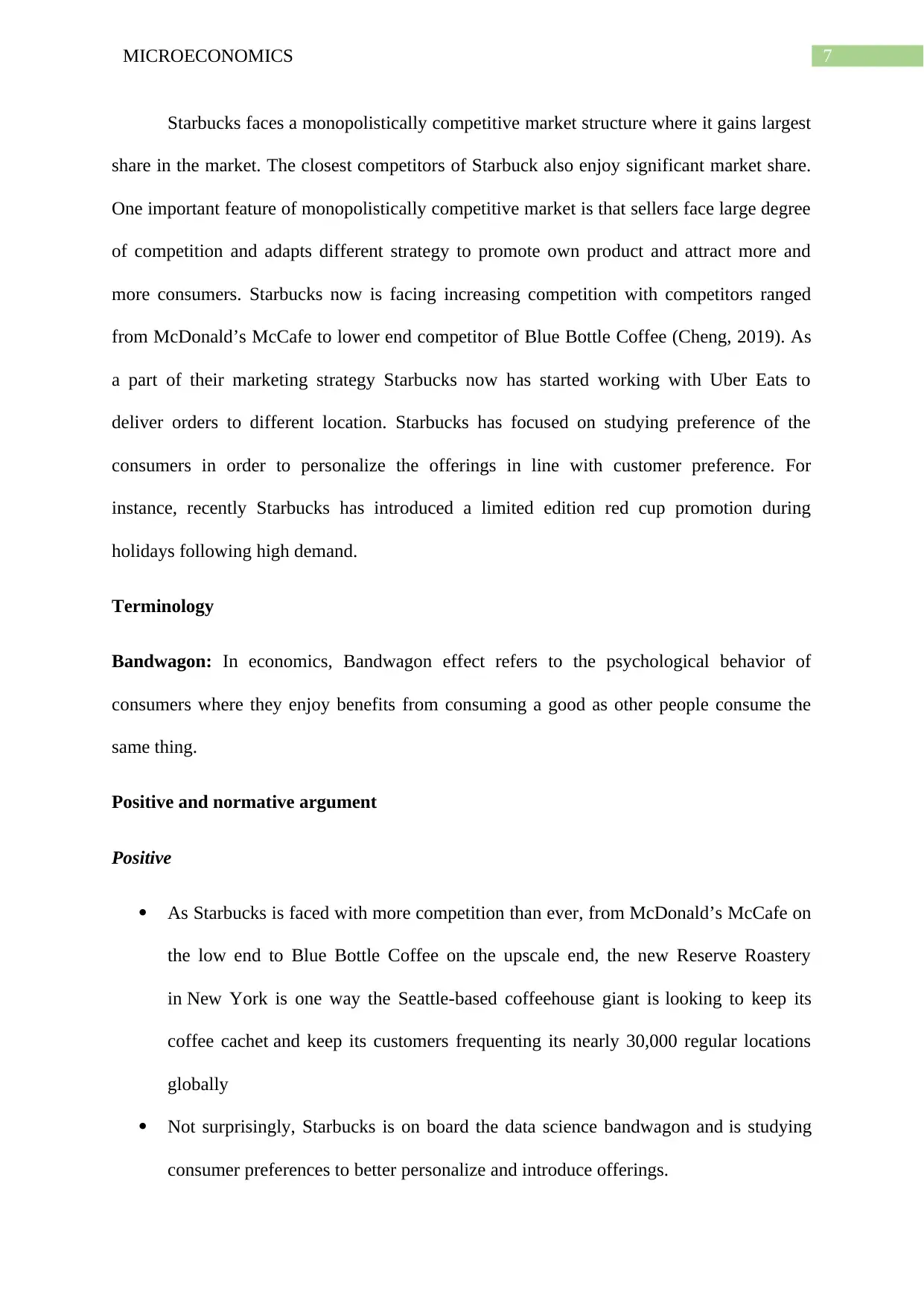
7MICROECONOMICS
Starbucks faces a monopolistically competitive market structure where it gains largest
share in the market. The closest competitors of Starbuck also enjoy significant market share.
One important feature of monopolistically competitive market is that sellers face large degree
of competition and adapts different strategy to promote own product and attract more and
more consumers. Starbucks now is facing increasing competition with competitors ranged
from McDonald’s McCafe to lower end competitor of Blue Bottle Coffee (Cheng, 2019). As
a part of their marketing strategy Starbucks now has started working with Uber Eats to
deliver orders to different location. Starbucks has focused on studying preference of the
consumers in order to personalize the offerings in line with customer preference. For
instance, recently Starbucks has introduced a limited edition red cup promotion during
holidays following high demand.
Terminology
Bandwagon: In economics, Bandwagon effect refers to the psychological behavior of
consumers where they enjoy benefits from consuming a good as other people consume the
same thing.
Positive and normative argument
Positive
As Starbucks is faced with more competition than ever, from McDonald’s McCafe on
the low end to Blue Bottle Coffee on the upscale end, the new Reserve Roastery
in New York is one way the Seattle-based coffeehouse giant is looking to keep its
coffee cachet and keep its customers frequenting its nearly 30,000 regular locations
globally
Not surprisingly, Starbucks is on board the data science bandwagon and is studying
consumer preferences to better personalize and introduce offerings.
Starbucks faces a monopolistically competitive market structure where it gains largest
share in the market. The closest competitors of Starbuck also enjoy significant market share.
One important feature of monopolistically competitive market is that sellers face large degree
of competition and adapts different strategy to promote own product and attract more and
more consumers. Starbucks now is facing increasing competition with competitors ranged
from McDonald’s McCafe to lower end competitor of Blue Bottle Coffee (Cheng, 2019). As
a part of their marketing strategy Starbucks now has started working with Uber Eats to
deliver orders to different location. Starbucks has focused on studying preference of the
consumers in order to personalize the offerings in line with customer preference. For
instance, recently Starbucks has introduced a limited edition red cup promotion during
holidays following high demand.
Terminology
Bandwagon: In economics, Bandwagon effect refers to the psychological behavior of
consumers where they enjoy benefits from consuming a good as other people consume the
same thing.
Positive and normative argument
Positive
As Starbucks is faced with more competition than ever, from McDonald’s McCafe on
the low end to Blue Bottle Coffee on the upscale end, the new Reserve Roastery
in New York is one way the Seattle-based coffeehouse giant is looking to keep its
coffee cachet and keep its customers frequenting its nearly 30,000 regular locations
globally
Not surprisingly, Starbucks is on board the data science bandwagon and is studying
consumer preferences to better personalize and introduce offerings.
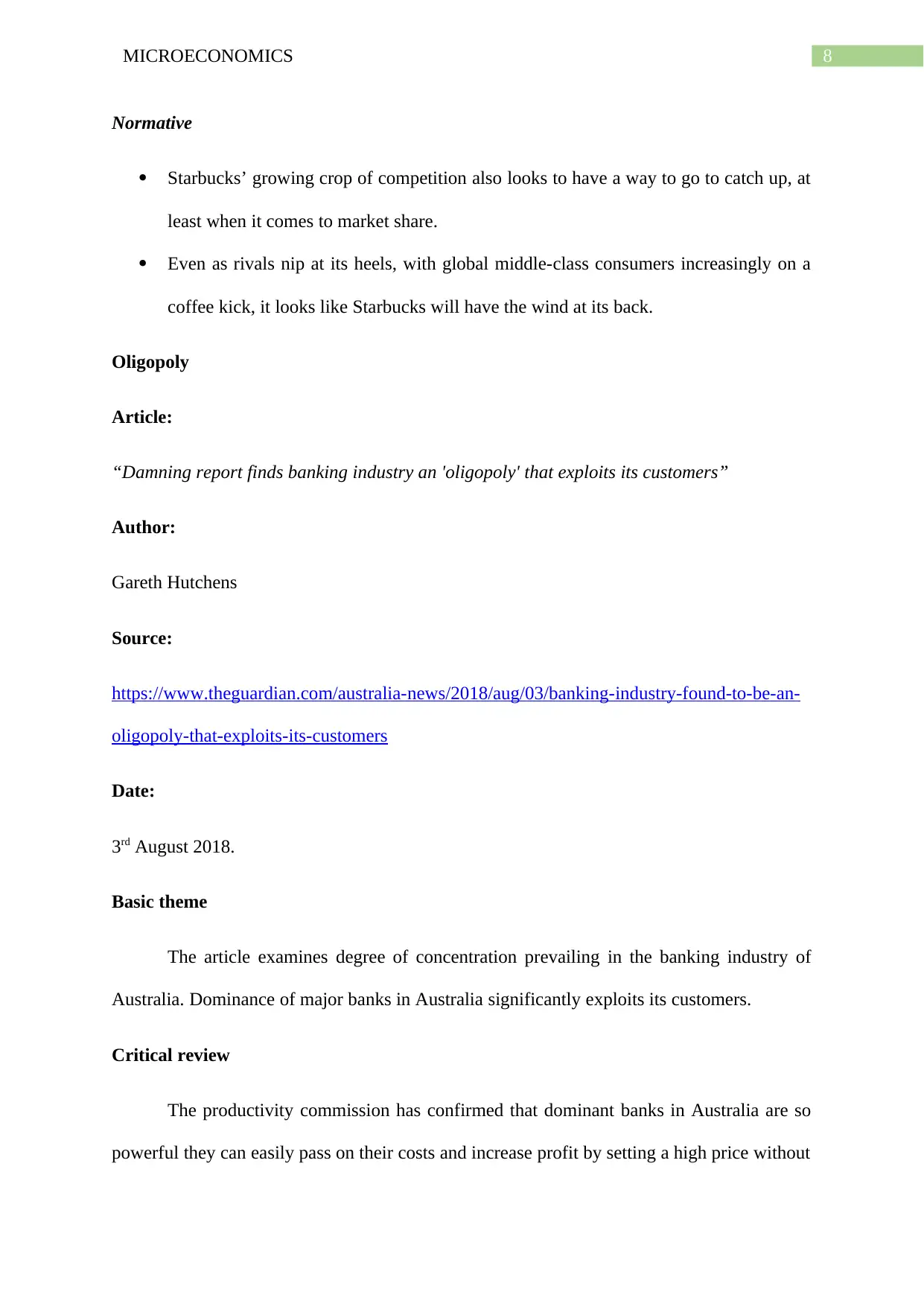
8MICROECONOMICS
Normative
Starbucks’ growing crop of competition also looks to have a way to go to catch up, at
least when it comes to market share.
Even as rivals nip at its heels, with global middle-class consumers increasingly on a
coffee kick, it looks like Starbucks will have the wind at its back.
Oligopoly
Article:
“Damning report finds banking industry an 'oligopoly' that exploits its customers”
Author:
Gareth Hutchens
Source:
https://www.theguardian.com/australia-news/2018/aug/03/banking-industry-found-to-be-an-
oligopoly-that-exploits-its-customers
Date:
3rd August 2018.
Basic theme
The article examines degree of concentration prevailing in the banking industry of
Australia. Dominance of major banks in Australia significantly exploits its customers.
Critical review
The productivity commission has confirmed that dominant banks in Australia are so
powerful they can easily pass on their costs and increase profit by setting a high price without
Normative
Starbucks’ growing crop of competition also looks to have a way to go to catch up, at
least when it comes to market share.
Even as rivals nip at its heels, with global middle-class consumers increasingly on a
coffee kick, it looks like Starbucks will have the wind at its back.
Oligopoly
Article:
“Damning report finds banking industry an 'oligopoly' that exploits its customers”
Author:
Gareth Hutchens
Source:
https://www.theguardian.com/australia-news/2018/aug/03/banking-industry-found-to-be-an-
oligopoly-that-exploits-its-customers
Date:
3rd August 2018.
Basic theme
The article examines degree of concentration prevailing in the banking industry of
Australia. Dominance of major banks in Australia significantly exploits its customers.
Critical review
The productivity commission has confirmed that dominant banks in Australia are so
powerful they can easily pass on their costs and increase profit by setting a high price without
⊘ This is a preview!⊘
Do you want full access?
Subscribe today to unlock all pages.

Trusted by 1+ million students worldwide
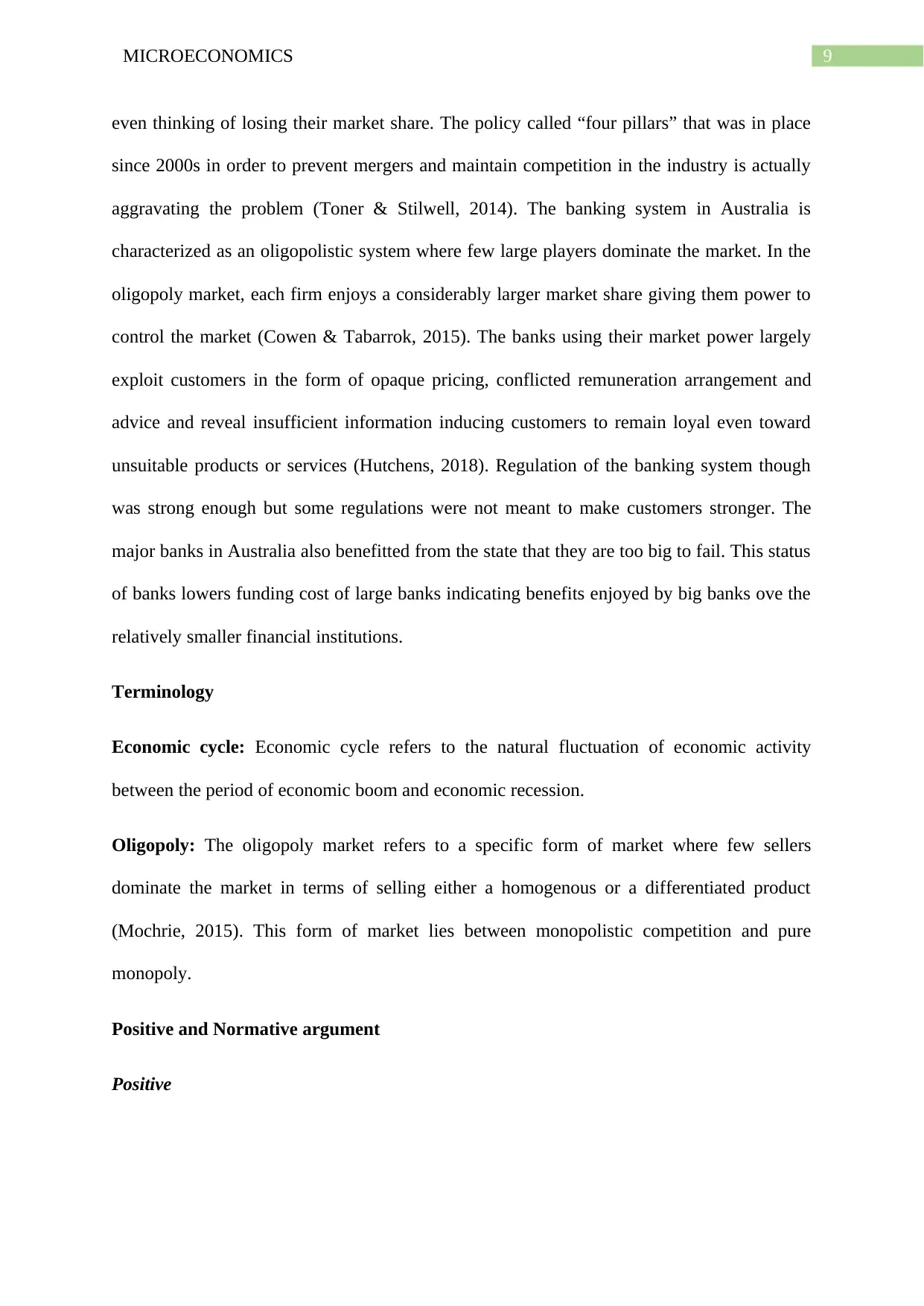
9MICROECONOMICS
even thinking of losing their market share. The policy called “four pillars” that was in place
since 2000s in order to prevent mergers and maintain competition in the industry is actually
aggravating the problem (Toner & Stilwell, 2014). The banking system in Australia is
characterized as an oligopolistic system where few large players dominate the market. In the
oligopoly market, each firm enjoys a considerably larger market share giving them power to
control the market (Cowen & Tabarrok, 2015). The banks using their market power largely
exploit customers in the form of opaque pricing, conflicted remuneration arrangement and
advice and reveal insufficient information inducing customers to remain loyal even toward
unsuitable products or services (Hutchens, 2018). Regulation of the banking system though
was strong enough but some regulations were not meant to make customers stronger. The
major banks in Australia also benefitted from the state that they are too big to fail. This status
of banks lowers funding cost of large banks indicating benefits enjoyed by big banks ove the
relatively smaller financial institutions.
Terminology
Economic cycle: Economic cycle refers to the natural fluctuation of economic activity
between the period of economic boom and economic recession.
Oligopoly: The oligopoly market refers to a specific form of market where few sellers
dominate the market in terms of selling either a homogenous or a differentiated product
(Mochrie, 2015). This form of market lies between monopolistic competition and pure
monopoly.
Positive and Normative argument
Positive
even thinking of losing their market share. The policy called “four pillars” that was in place
since 2000s in order to prevent mergers and maintain competition in the industry is actually
aggravating the problem (Toner & Stilwell, 2014). The banking system in Australia is
characterized as an oligopolistic system where few large players dominate the market. In the
oligopoly market, each firm enjoys a considerably larger market share giving them power to
control the market (Cowen & Tabarrok, 2015). The banks using their market power largely
exploit customers in the form of opaque pricing, conflicted remuneration arrangement and
advice and reveal insufficient information inducing customers to remain loyal even toward
unsuitable products or services (Hutchens, 2018). Regulation of the banking system though
was strong enough but some regulations were not meant to make customers stronger. The
major banks in Australia also benefitted from the state that they are too big to fail. This status
of banks lowers funding cost of large banks indicating benefits enjoyed by big banks ove the
relatively smaller financial institutions.
Terminology
Economic cycle: Economic cycle refers to the natural fluctuation of economic activity
between the period of economic boom and economic recession.
Oligopoly: The oligopoly market refers to a specific form of market where few sellers
dominate the market in terms of selling either a homogenous or a differentiated product
(Mochrie, 2015). This form of market lies between monopolistic competition and pure
monopoly.
Positive and Normative argument
Positive
Paraphrase This Document
Need a fresh take? Get an instant paraphrase of this document with our AI Paraphraser
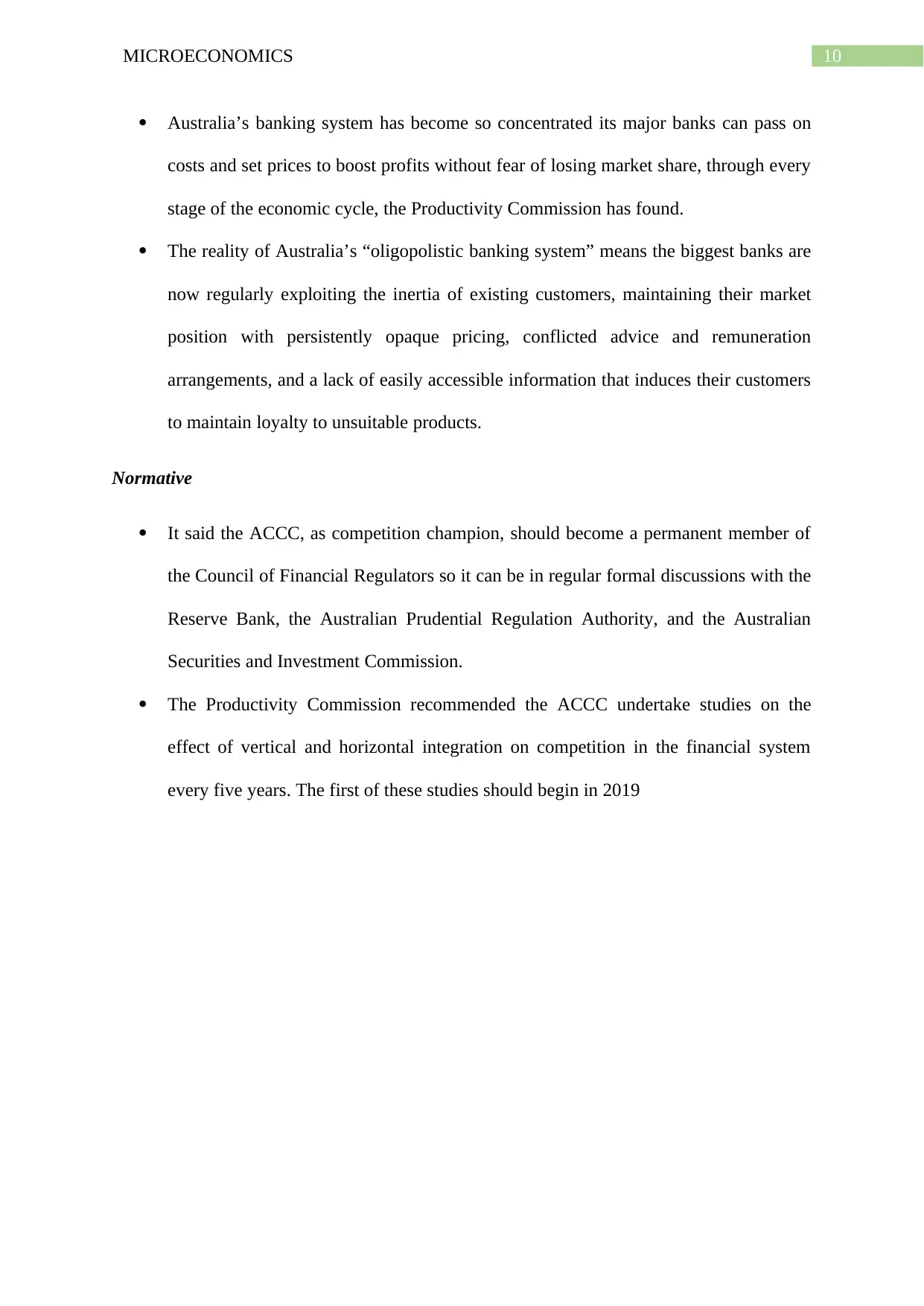
10MICROECONOMICS
Australia’s banking system has become so concentrated its major banks can pass on
costs and set prices to boost profits without fear of losing market share, through every
stage of the economic cycle, the Productivity Commission has found.
The reality of Australia’s “oligopolistic banking system” means the biggest banks are
now regularly exploiting the inertia of existing customers, maintaining their market
position with persistently opaque pricing, conflicted advice and remuneration
arrangements, and a lack of easily accessible information that induces their customers
to maintain loyalty to unsuitable products.
Normative
It said the ACCC, as competition champion, should become a permanent member of
the Council of Financial Regulators so it can be in regular formal discussions with the
Reserve Bank, the Australian Prudential Regulation Authority, and the Australian
Securities and Investment Commission.
The Productivity Commission recommended the ACCC undertake studies on the
effect of vertical and horizontal integration on competition in the financial system
every five years. The first of these studies should begin in 2019
Australia’s banking system has become so concentrated its major banks can pass on
costs and set prices to boost profits without fear of losing market share, through every
stage of the economic cycle, the Productivity Commission has found.
The reality of Australia’s “oligopolistic banking system” means the biggest banks are
now regularly exploiting the inertia of existing customers, maintaining their market
position with persistently opaque pricing, conflicted advice and remuneration
arrangements, and a lack of easily accessible information that induces their customers
to maintain loyalty to unsuitable products.
Normative
It said the ACCC, as competition champion, should become a permanent member of
the Council of Financial Regulators so it can be in regular formal discussions with the
Reserve Bank, the Australian Prudential Regulation Authority, and the Australian
Securities and Investment Commission.
The Productivity Commission recommended the ACCC undertake studies on the
effect of vertical and horizontal integration on competition in the financial system
every five years. The first of these studies should begin in 2019
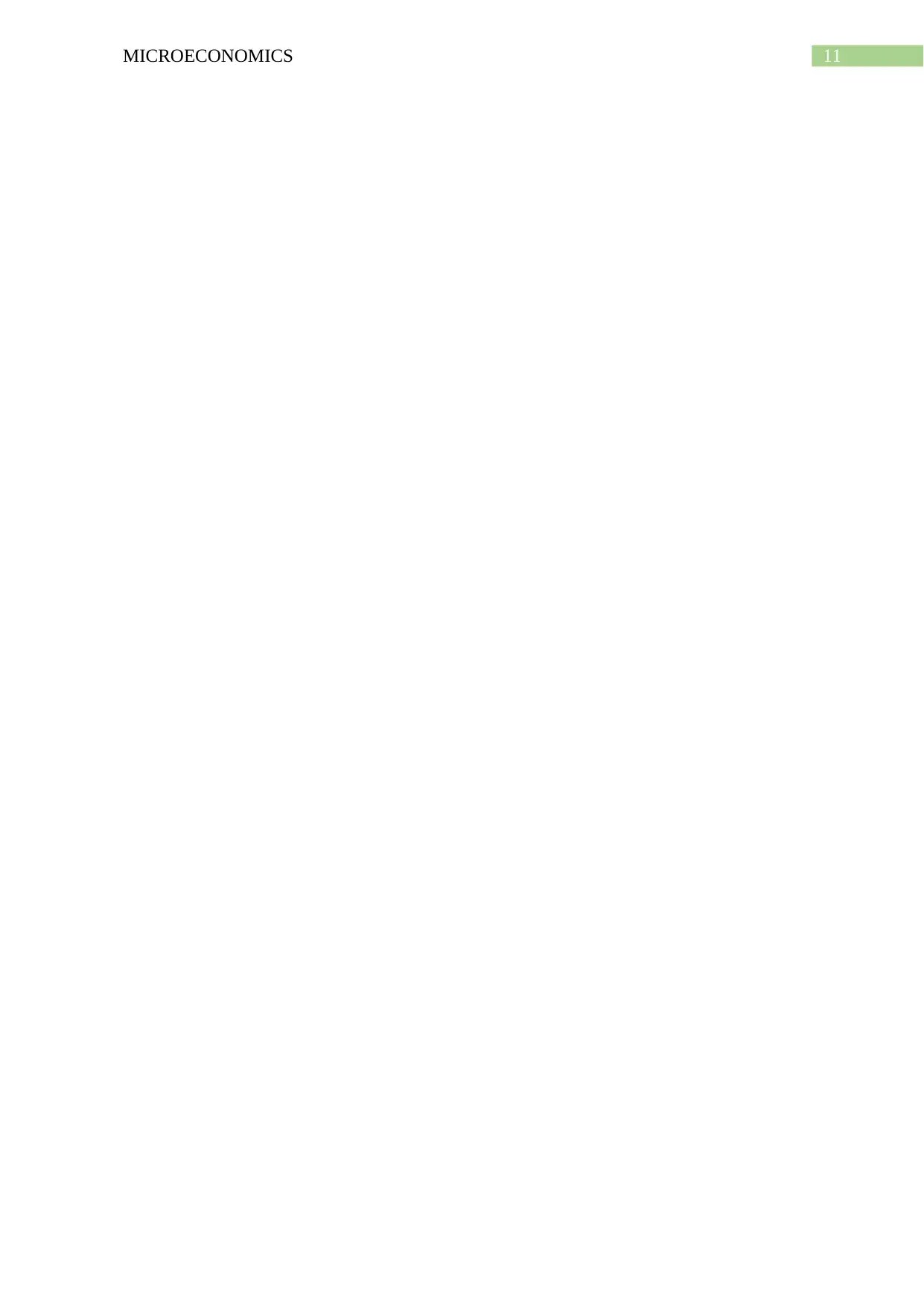
11MICROECONOMICS
⊘ This is a preview!⊘
Do you want full access?
Subscribe today to unlock all pages.

Trusted by 1+ million students worldwide
1 out of 14
Related Documents
Your All-in-One AI-Powered Toolkit for Academic Success.
+13062052269
info@desklib.com
Available 24*7 on WhatsApp / Email
![[object Object]](/_next/static/media/star-bottom.7253800d.svg)
Unlock your academic potential
Copyright © 2020–2025 A2Z Services. All Rights Reserved. Developed and managed by ZUCOL.





